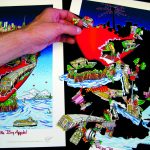
These variations of printmaking produce different types of original prints: Silkscreen Printing, Etching, Collagraph, Woodcut, Linocut, Lithography and others. Original printmaking does not involve a painting being painted, photographed (or scanned) to turn it into a computer file printed from a large format computerised printer.Ī printmaker sets out to create a print, and only a print – there is no (‘master’) painting.Įach print in an edition is personally and methodically made by the printmaker. Original prints are not photographic, or scanned, copies of paintings. Here is an example of my Original Artwork of ‘Joy’, all the colours in this artwork are hand painted in acrylic, only the black is printed by silkscreen. They are priced higher than my Original Prints because they are one offs. I consider them to be as original as an oil painting. I experiment with different papers, colours, positioning and often hand paint layers with acrylic. They are usually created as experiments and are the first time I will have created that image. These are silkscreen prints that are completely original and not part of an edition. I have some pieces on my website that are Original Artwork. The inks I use are slightly raised on the paper and have a soft sheen which contrasts with the velvety matt surface of the paper. If you look closely at my original hand-made silkscreen prints you can see differences in texture and sheen between the ink and the paper. Slight differences in the amount of ink applied and the pressure on the press make each print unique. Signing and numbering prints (as part of a limited edition) does not necessarily mean that the print is a hand-printed original.
SILKSCREEN PAINTING SERIES
Each colour in the print is printed separately.Įach print, although it may be one of a numbered series (or edition) is a unique, original, hand-crafted piece of art. Although the image is the same in an edition of hand-made prints, no two are exactly identical as each one has been individually printed.

In screen printing the inks are mixed by hand and pulled through the silkscreen (which has a negative stencil of the image to be printed) by hand using a squeegee. Creating an original print using one of these processes usually involves many hours in the studio, infinite patience and experience with an array of chemicals, plates and (often ancient) equipment!

Only hand-printed work that has been manually produced by the artist can be called an original print. Anything else is simply a copy or reproduction.Įxamples of traditional print-making processes include linocut, woodcut, etching, screen-printing, monotype and collograph. They are produced by hand from a printing plate or silkscreen which can be made by hand or created digitally, or a combination of both. The plates or silkscreen it is printed from bear no resemblance to the finished work of art, which means it is not a copy or a reproduction of anything.

Hand-made prints are not a digital reproduction. The word ‘print’ is used to describe both digitally reproduced and hand-printed work (such as printmaking) and it is not always clear to buyers which process has been used to reproduce the print. Definition of a Print:Ī print is a picture, text or design often produced in multiple copies, by applying ink to paper or other material by various processes.

I’m hoping the following information will help you understand the differences between Prints, Original Prints, Limited Editions, Original Artworks and Giclee Prints….


 0 kommentar(er)
0 kommentar(er)
